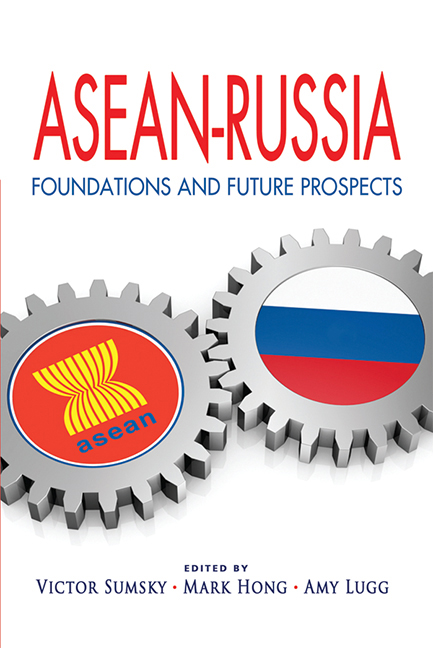Book contents
- Frontmatter
- Contents
- Foreword
- Preface
- About the Contributors
- Keynote Address
- Opening Remarks
- Keynote Address
- Introduction: Russia and the ASEAN Member States: Political and Economic Cooperation in Progress
- SECTION I WISEMEN'S VIEWS
- SECTION II GEOPOLITICS
- SECTION III BILATERAL RELATIONS
- SECTION IV Business and Economics
- Russia and ASEAN-4: Potential and Realms of Cooperation
- Russia's Economic Relations with the APEC Region
- Russia Looks East: Modernization Plans and Cooperation with ASEAN
- Indonesian and Russian Oilmen: Sharing Experiences and Learning from Each Other
- Towards a Roadmap for Russia-ASEAN Trade and Economic Cooperation
- The Best Cities to Buy Into
- SECTION V CULTURE AND EDUCATION
- EPILOGUE
- Index
Russia's Economic Relations with the APEC Region
from SECTION IV - Business and Economics
Published online by Cambridge University Press: 21 October 2015
- Frontmatter
- Contents
- Foreword
- Preface
- About the Contributors
- Keynote Address
- Opening Remarks
- Keynote Address
- Introduction: Russia and the ASEAN Member States: Political and Economic Cooperation in Progress
- SECTION I WISEMEN'S VIEWS
- SECTION II GEOPOLITICS
- SECTION III BILATERAL RELATIONS
- SECTION IV Business and Economics
- Russia and ASEAN-4: Potential and Realms of Cooperation
- Russia's Economic Relations with the APEC Region
- Russia Looks East: Modernization Plans and Cooperation with ASEAN
- Indonesian and Russian Oilmen: Sharing Experiences and Learning from Each Other
- Towards a Roadmap for Russia-ASEAN Trade and Economic Cooperation
- The Best Cities to Buy Into
- SECTION V CULTURE AND EDUCATION
- EPILOGUE
- Index
Summary
INTRODUCTION
Since its inception, the Asia Pacific Economic Cooperation (APEC) forum has been working to build a sense of a strong Asia-Pacific community, based on the following economic pillars: trade and investment liberalization, business facilitation and economic and technical cooperation. When Russia became a full member of APEC in November 1998, this news was received with some scepticism by the public in the Asia-Pacific region. As opposed to Peru and Vietnam, the other two newly admitted members in 1998, Russia's economic links with APEC members were not that strong at that time.
For example, whereas Peru and Vietnam exported 53.2 per cent and 67.3 per cent of their world exports to APEC in 1998, Russia only exported 18.2 per cent of its total exports to APEC. In the same way, the proportion of imports from APEC was lower in the case of Russia, at 19.2 per cent, as opposed to Peru and Vietnam (55.2 per cent and 83.5 per cent, respectively).
Russia's membership in APEC is not an isolated case of engagement with the Asia-Pacific region. It is a result of a series of previous approaches within the region. In fact, Russia's interest in the Asia Pacific is not recent and dates back from the years of the Soviet Union.
As part of the strategy to develop further relationships with the Asia Pacific, the Soviet Union started its engagement with the Pacific Economic Cooperation Council (PECC) in 1988 through the Soviet National Committee on Asia Pacific Economic Cooperation (SOVNAPEC). PECC is a tripartite partnership of individuals from business, government and academia interested in the Asia-Pacific region. SOVNAPEC formally joined PECC as a full member in September 1991 and in June 1992, the Russian National Committee on Pacific Economic Cooperation was confirmed as the successor to SOVNAPEC.
- Type
- Chapter
- Information
- ASEAN-RussiaFoundations and Future Prospects, pp. 219 - 244Publisher: ISEAS–Yusof Ishak InstitutePrint publication year: 2012



